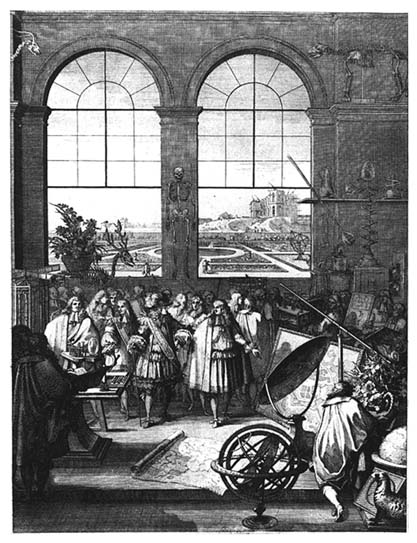Public Image
The most intelligible introduction to the Académie royale des sciences is through published portraits. Sébastien Le Clerc developed the Academy's public image in several contemporary engravings. The best known of these dates from 1671 and shows what seems to be a visit of Louis XIV and Colbert to the Academy (plate 1). Others depict academicians examining objects in microscopes, discussing, performing a dissection, working in the chemical laboratory, and carrying out other scientific tasks. These engravings were intended both for nonscientific audiences — the king-patron, the recipients of presentation copies of engravings commissioned by the crown, and collectors — and for more knowledgeable readers of the Academy's books, which the prints illustrated. Each engraving presents a self-contained portrait, each is a deliberate public image of a royal establishment, and all allude to traits that are essential to understanding the Academy.
Le Clerc's formal portrait of the king, Colbert, and the Academy is both factual and fantastic. The artist at once portrays and misrepresents the Academy in ways that have stimulated and perplexed historians.[1] On the factual level, Le Clerc represents the Academy's experimentalist credo, its accomplishments, and its members. A lavish display of objects suggests the Academy's interests. Skeletons of dissected animals adorn the walls. Scientific instruments are everywhere. Maps, laboratory apparatus, plants, and models of machines reveal that the Academy's research program was broadly defined. The engraver portrayed academicians accurately, differentiating subjects by their garb, so that the viewer can distinguish clerical and lay academicians, identify members of the royal family, and grasp the social status of each person.[2]
It is not surprising that a portrait of the Academy by Le Clerc should reveal such an eye for detail and sensitivity to nuance. Le Clerc himself was

Plate 1. The Academy and Its Protectors. In the front are, from left to right, the
prince de Condé, the duc d'Orléans, Louis XIV, and Colbert. Cassini, gesturing
with his left hand, is between Condé and the king's brother, while Perrault
stands between Louis and Colbert. (Watson, "Early Days"; drawn by Goyton,
engraved by Le Clerc; photograph courtesy of Bibliothèque Nationale, Paris.)
not only a skilled draftsman and engraver but also an engineer who studied mathematics, natural philosophy, and cosmography. Furthermore, the Academy sponsored some of the best scientific illustration of the century, and Le Clerc helped make its anatomical illustrations acknowledged masterpieces of the time.
Le Clerc also portrayed the Academy in ways that are misleading, although even his misrepresentations convey truths about the institution. For example, he stressed the Academy's experimentalist bias at the expense of its fairly cautious theorizing. He did not delineate the entire scope of the Academy's research but rather created the impression of catholic interests and emphasized subjects, especially those with practical applications, on which Colbert spent the largest sums of money. The Academy did not limit its scientific inquiries, but its patrons preferred some fields over others, and they made their preferences evident in material ways that Le Clerc captured.
By grouping academicians and showing them in conversation, Le Clerc conveyed a collaborative spirit at the Academy, where members worked together. What Le Clerc did not show was that personal rivalries and professional disagreements enervated academicians, many of whom found it more productive to work individually than in teams.
The physical setting of Le Clerc's portrait is also misleading. The view outside the room where academicians are assembled shows the Observatory. In fact, no such prospect was possible from any of the Academy's three principal locations — the King's Library, the King's Garden, and the Observatory — none of which could be seen from any other. By including the Observatory in the portrait, Le Clerc sacrificed accurate topography but conveyed royal munificence, for the Observatory was constructed entirely with royal funds.
Finally, the central event did not occur as Le Clerc suggests, for the king did not visit the Academy until ten years after Le Clerc depicted the supposed occurrence. Even then, in December 1681, Louis was a reluctant visitor; although Colbert had long tried to persuade him to see his creation at first hand, the king continually dragged his heels. No scientific amateur, he lacked the knowledge to ask the kinds of well-informed and detailed questions that James II of England, for example, would pose on a visit to the Observatory in 1690. Louis was a patron of science not out of intellectual interest but out of self-interest predicated on the practical advantages that would accrue from his intervention. His appearance in the engraving does not correspond to the facts but is meant to convey, through artistic license, a royal seal of approval.[3]
Le Clerc's portrait of the Academy contributes to a program of royal propaganda. He makes it obvious that the king was the Academy's generous patron, entitled to share whatever acclaim its work received. The resulting public image of the Academy is that of a splendidly equipped royal foundation, dedicated to the experimental ideal and to the cooperative pursuit of broad interests. He makes it obvious that the Academy has a dual function: to make scientific discoveries and to honor the king.